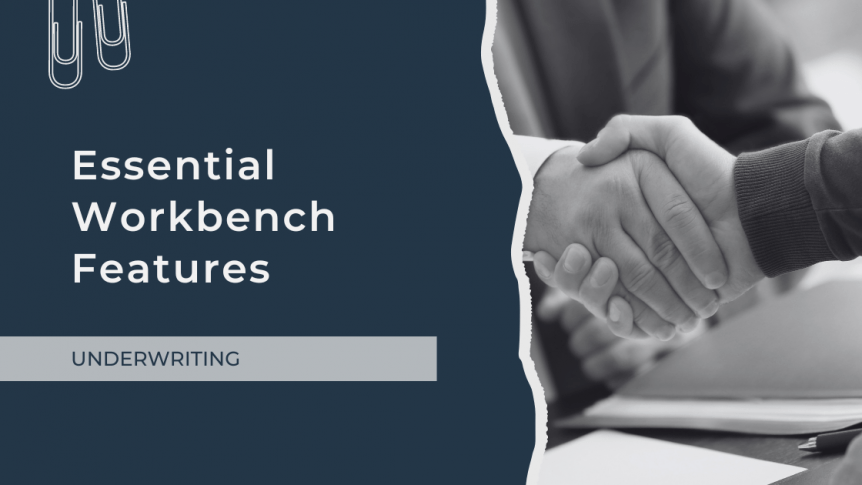Full article with thanks to: techround.co.uk/guides/features-need-underwriting-workbench
Global underwriters are increasingly adopting underwriting workbenches to streamline workflows, integrating established technologies with cutting-edge advancements in AI automation and data-driven decision-making. These professionals typically use diverse tools daily, scattered across an insurer’s tech ecosystem. An underwriter’s workbench neatly consolidates these tools into a unified, streamlined interface.
In this article, we will explore the definition of an underwriting workbench, uncovering its growing significance in today’s fiercely competitive insurance market, and spotlight the key 8 features to keep an eye out for.
What is an Underwriting Workbench?
An underwriting workbench serves as a centralised hub, offering underwriters a dedicated platform for their passion—underwriting! Providing access to essential tools, data, and insights from submission to binding, streamlines the entire process.
Tailored insurance-focused tools automate administrative tasks, expediting underwriting and, importantly, restoring valuable time and insights to underwriters. This encompasses automated risk rule management, collaborative underwriter tools, and innovative features that enhance efficiency and accuracy throughout the underwriting journey.
Why are Underwriting Workbenches so Popular?
The rising popularity of underwriting workbenches is attributed to the large amount of benefits they provide. These systems go beyond improving audit and compliance oversight or simplifying data processes; they also centralise data, elevating the efficiency and accuracy of an underwriter’s tasks. Undoubtedly, underwriting workbenches exert a positive influence on day-to-day operations.
Top 8 Features of an Underwriting Workbench
Underwriting workbenches don’t have to be identical; the flexibility lies in the fact that underwriters can customise their workbenches according to the specific requirements of their business line. Nonetheless, we have identified eight features of an underwriting workbench that can assist underwriters in optimising their workflow.
1. Scalability
In the ever-evolving finance landscape, the scalability of underwriting workbench software is imperative. Whether catering to the needs of a burgeoning entity with modest underwriting demands or an enterprise grappling with a high volume of transactions, the software should seamlessly adapt. Scalability ensures that the software remains a dependable ally, adjusting to evolving business needs and eliminating the need for frequent overhauls.
2. Comprehensive Risk Management Solutions
At the core of underwriting lies risk assessment, a facet demanding a diverse set of tools. The ideal software should unveil features facilitating comprehensive credit scoring, predictive modelling, and scenario analysis. Its versatility should extend to encompass a spectrum of risks across financial, market, and operational domains. A comprehensive suite of risk assessment tools empowers underwriters to make well-informed decisions resilient against potential threats.
3. Unified Collaboration Tools
Underwriting intricacies often involve a symphony of stakeholder collaboration. The software should be equipped with collaboration tools that facilitate seamless communication, document sharing, and collaborative decision-making. Instrumental features like comment threads, document versioning, and role-based access controls contribute to forging an efficient and cohesive underwriting team.
4. Automation and Artificial Intelligence (AI)
The underwriting landscape has undergone a paradigm shift with the infusion of automation and AI. These technologies now handle repetitive tasks, data analysis, and decision-making. The quest is for software that integrates automation, streamlining mundane tasks like data entry and document verification. AI algorithms, proficient in analysing voluminous datasets, enhance risk assessment precision, elevating both efficiency and decision-making accuracy.
5. User-Friendly Design
The selection of underwriting workbench software begins with the user interface. The design should not only be functional but also user-friendly. An easily navigable design fosters seamless access to key functions, streamlining workflow and presenting information in a lucid and organised manner. This facet not only boosts user satisfaction but also catalyses faster and more accurate decision-making.
6. Versatile Data Integration
The multifaceted nature of effective underwriting necessitates the software’s proficiency in integrating with diverse data sources. The ideal software should seamlessly connect with external databases, third-party systems, and other relevant repositories of information. Integration with customer relationship management systems (CRM), data analytics tools, and industry databases becomes crucial for a holistic risk assessment.
7. Compliance Management
In the labyrinth of financial and insurance domains, where regulations reign supreme, underwriting workbench software should be fortified with compliance management features. Automated checks for alignment with industry regulations, data protection laws, and internal policies become indispensable. Compliance management transcends being a mere checkbox; it becomes the vanguard against legal conundrums and a guarantor of the overall integrity of the underwriting process.
8. Transparent Accountability with Audit Trail and Reporting
Transparency and accountability are upheld through a robust audit trail feature. This vigilant observer tracks changes, decisions, and actions within the software. The symbiotic feature of reporting amplifies transparency, offering insights into performance, trends, and meeting reporting mandates. Together, they form the cornerstone for not just retrospective analysis but a continual evolution of the underwriting process.
Full article with thanks to: techround.co.uk/guides/features-need-underwriting-workbench
Did you enjoy that? Why not share this article.
We specialise in supporting change across the insurance sector, helping insurance businesses (and other businesses like distribution and logistics) adapt seamlessly.
Our services include Change & Transformation, M&A Integration, Business Process Management and Executive Coaching. We help make organisational change and technology change much easier.
Got a question about our services? Get in touch and leave a message

